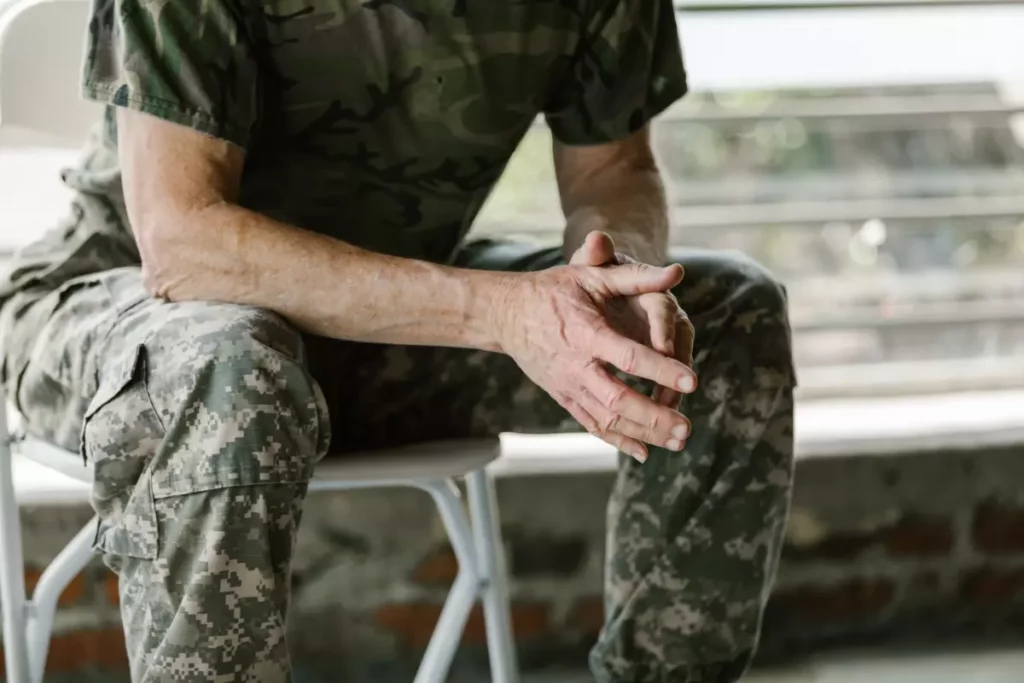In support of June being PTSD Month, let’s salute our veterans for their bravery on the battlefield, and remember – some of their most brutal battles are fought in silence long after the war has ended.
The co-occurrence of PTSD and substance abuse among veterans is a pressing issue that demands our attention.
Join us as we delve into the intricacies of these intertwined struggles, unpacking the causes, consequences, and solutions in our commitment to supporting the heroes who’ve risked it all for our freedom.
Understanding PTSD
WHAT IS PTSD?
Post-Traumatic Stress Disorder (PTSD) is a mental health condition triggered by experiencing or witnessing a terrifying event.
It can develop after exposure to a traumatic incident such as warfare, sexual assault, a natural disaster, or a severe accident.
Symptoms of PTSD may include flashbacks or nightmares about the traumatic event, hypervigilance, exaggerated startle response, difficulty sleeping, and changes in mood and cognitive processes, such as difficulty concentrating or feelings of detachment.
These symptoms can disrupt daily life, making it hard for those affected to function in their social, occupational, or other vital areas.
The condition is not a sign of weakness, and individuals with PTSD often require professional treatment to heal and manage their symptoms.
| Understanding PTSD | |
|---|---|
| Definition | Post-Traumatic Stress Disorder (PTSD) is a mental health condition triggered by experiencing or witnessing a terrifying event, leading to intense, disturbing thoughts and feelings related to the experience long after the event has ended. |
| Symptoms |
|
PTSD AND SUBSTANCE ABUSE
The relationship between Post-Traumatic Stress Disorder (PTSD) and substance abuse is complex and deeply intertwined.
People who have PTSD often struggle with intense symptoms, such as intrusive memories, emotional numbness, and increased anxiety, which can be incredibly distressing and overwhelming.
To manage these symptoms, some individuals may turn to substances such as alcohol, illicit drugs, or prescription medication as a form of self-medication.
The temporary relief these substances provide can create a pattern of use that can quickly escalate to dependency and addiction.
On the other hand, substance abuse can exacerbate PTSD symptoms, making it harder for individuals to manage their condition.
Drugs or alcohol can enhance feelings of depression and anxiety, leading to more frequent and severe flashbacks.
In essence, PTSD and substance abuse can feed into each other in a negative cycle that amplifies both disorders, creating a dual diagnosis that is challenging to treat.
| Common Substances and Behaviors Associated with PTSD and Addiction | |
|---|---|
| Substance Addictions |
|
| Behavioral Addictions |
|
PTSD in Veterans
UNDERSTANDING PTSD IN VETERANS
Veterans are particularly susceptible to Post-Traumatic Stress Disorder (PTSD) due to the nature of their service.
The military context often exposes service members to numerous and sometimes prolonged traumatic events, including combat exposure, witnessing death or injury, and sexual trauma.
For many veterans, these experiences can lead to the development of PTSD.
Symptoms in veterans may mirror those in the general population but can also be influenced by specific military factors.
Veterans may experience intrusive memories or flashbacks of combat, hyperarousal in response to noises or situations that remind them of war, and avoidance of circumstances that bring up memories of their service.
The condition may lead to social or occupational functioning difficulties, with some veterans struggling with maintaining relationships, employment, and overall quality of life1.
The military’s unique culture and experiences often add complexity to the recognition, diagnosis, and treatment of PTSD in veterans.
| Symptom | Description |
|---|---|
| Combat-related Flashbacks | Experiencing intense, often distressing, memories of combat events as if they were happening in the present. |
| Hyperarousal to war-related cues | It increased emotional and physical response to stimuli that remind the individual of their military services, such as loud noises, helicopters, or certain smells. |
| Avoidance of war-related stimuli | They avoid places, situations, or people that remind them of the traumatic events experienced during service. |
| Alienation from civilian life | I felt detached or estranged from others, often struggling to reconnect with life outside the military. |
| Guilt or shame related to combat. | We are experiencing persistent feelings of guilt or shame related to moral injury (actions taken or witnessed in combat that violate personal beliefs or moral code). |
PTSD TRIGGERS SPECIFIC TO VETERANS
Veterans may experience unique triggers for Post-Traumatic Stress Disorder (PTSD) due to the specific nature of their military service.
Combat exposure can be significant triggers, including witnessing death or injury, experiencing a hostile fire, and the constant threat of potential harm.
Non-combat experiences, such as military sexual trauma (MST), which includes sexual harassment and sexual assault experienced during military service, can also lead to PTSD.
Further, the transitions associated with military service, like frequent moves or deployments, separation from family, or the adjustment to civilian life, can also be stressors that trigger PTSD.
Even everyday sights, sounds, or situations – such as crowded places, loud noises, or certain smells – may remind a veteran of a traumatic event and trigger PTSD symptoms.
These unique triggers add a layer of complexity to the understanding and treatment of PTSD in veterans.
| Trigger | Description |
|---|---|
| Combat Exposure | I am experiencing or witnessing violence, injury, or death during combat. |
| Military Sexual Trauma (MST) | Experiencing sexual harassment or sexual assault during military service. |
| Frequent Deployments | Repeated and extended separations from family and loved ones can be a significant source of stress. |
| Transition to Civilian Life | Adjusting to civilian life, including finding employment and reconnecting with family and friends, can trigger PTSD symptoms. |
| Everyday Reminders | Loud noises, crowded places, or certain smells can remind a veteran of a traumatic event and trigger PTSD symptoms. |
ALARMING STATISTICS AMONG VETERANS
Post-Traumatic Stress Disorder (PTSD) is a significant public health concern among veterans.
The U.S. Department of Veterans Affairs estimates that PTSD afflicts approximately 11-20% of Operations Iraqi Freedom (OIF) and Enduring Freedom (OEF) veterans in a given year2.
This figure rises to about 12% annually for Gulf War (Desert Storm) veterans.
Of the veterans of the Vietnam War, about 15% were diagnosed with PTSD at the time of the most recent study in the late 1980s, but it’s estimated that approximately 30% have had PTSD in their lifetime.
PTSD in veterans is also associated with a high degree of comorbidity, particularly with substance use disorders, major depressive disorder, and anxiety disorders.
This complex picture underscores the critical importance of providing adequate mental health services to veterans.
Substance Abuse in Veterans
PTSD AND SUBSTANCE ABUSE IN VETERANS
PTSD and substance abuse commonly co-occur in veterans, presenting a complex and challenging issue.
PTSD, resulting from exposure to traumatic events during military service, can lead to distressing symptoms such as flashbacks, nightmares, and hypervigilance.
To cope with these symptoms, many veterans turn to substance abuse as a form of self-medication3.
However, substance abuse can exacerbate PTSD symptoms and hinder recovery.
The relationship between PTSD and substance abuse is bidirectional, with each condition influencing and reinforcing the other.
Enhanced awareness, early detection, and accessible mental health resources are crucial to supporting veterans facing the challenges of PTSD and substance abuse.
COMMON SUBSTANCES ABUSED AMONG VETERANS
Substance abuse among veterans tends to involve alcohol, prescription drugs, and illicit substances.
Alcohol is the most commonly abused substance, with the drinking culture in the military often contributing to its prevalence.
Many veterans turn to alcohol as a coping mechanism to deal with the stresses of military life and the transition to civilian life.
Prescription drug misuse, particularly of opioids and benzodiazepines, is also a significant concern.
These medications are often prescribed to manage pain from physical injuries or to help cope with anxiety or insomnia, but they carry a high risk of dependency.
Although less common, illegal drug use occurs, with marijuana and cocaine being the most frequently used.
The use of these substances can lead to Substance Use Disorders, which often co-occur with other mental health conditions like PTSD, adding another layer of complexity to the challenge of treatment and recovery for veterans.
| Substance | Description |
|---|---|
| Alcohol | The most commonly abused substance among veterans is often used as a coping mechanism to handle stress and emotional distress related to military service and transitioning to civilian life. |
| Prescription Drugs (Opioids and Benzodiazepines) | Prescription medications, such as opioids for pain management and benzodiazepines for anxiety or sleep disorders, can lead to misuse and dependence due to their addictive properties. |
| Marijuana | While less common than alcohol or prescription drug misuse, some veterans turn to marijuana, an illicit substance, as a means to self-medicate symptoms of PTSD and other mental health issues. |
| Cocaine | Though not as widespread, the use of stimulants like cocaine is reported among veterans. This powerful stimulant can lead to serious health issues and addiction. |
OTHER CONTRIBUTING FACTORS
Several factors contribute to the heightened risk of substance abuse in veterans.
The physical injuries and chronic pain that some veterans sustain during service can lead to prescription medication use and potential misuse, particularly opioids.
Additionally, the challenges associated with transitioning from military to civilian life, such as feeling alienated, difficulty finding employment, or struggles with reintegration into family life, can also lead to substance abuse as a form of self-medication.
Lastly, the prevalence of a heavy drinking culture in the military environment can normalize excessive alcohol use, making it a more likely choice for stress coping.
Understanding these contributing factors is crucial in developing effective prevention and treatment strategies for substance abuse in veterans.
CONSEQUENCES OF SUBSTANCE ABUSE ON PHYSICAL AND MENTAL HEALTH
Substance abuse can have profound consequences on veterans’ physical and mental health.
Physically, chronic substance use can lead to various health problems, including liver disease, cardiovascular disease, respiratory issues, and increased risk of overdose and death, especially when involving opioids.
The misuse of substances can also exacerbate pre-existing physical conditions, such as injuries sustained during service.
Mentally, substance abuse often intensifies symptoms of mental health disorders like PTSD, depression, and anxiety.
It can lead to increased feelings of isolation, guilt, and shame, potentially resulting in a vicious cycle of increased substance use.
Moreover, substance abuse can reduce the effectiveness of treatments for these mental health conditions.
Finally, chronic substance abuse can contribute to social and occupational problems, such as job loss, relationship difficulties, and homelessness, further exacerbating mental health issues and making recovery more challenging.
Available Treatment Approaches
With an alarming statistic of 17 Veterans killing themselves every day, immediate treatment and resources must be available for those in need!
Here are some of the treatment approaches available today:
COGNITIVE-BEHAVIORAL THERAPIES (E.G., COGNITIVE PROCESSING THERAPY, PROLONGED EXPOSURE)
Cognitive-behavioral therapies (CBTs), such as Cognitive Processing Therapy (CPT) and Prolonged Exposure (PE), are valuable therapeutic approaches used to treat PTSD in veterans4.
CPT is designed to help veterans recognize and alter negative thought patterns related to their traumatic experiences.
By working through these cognitive distortions, veterans can better understand how these events have impacted their perceptions and beliefs, improving their overall mental well-being.
On the other hand, therapy systematically exposes veterans to thoughts, emotions, and situations related to their trauma that they’ve been avoiding.
Gradual and controlled exposure reduces fear responses and avoidance behaviors associated with traumatic memories.
Both therapies have effectively reduced PTSD symptoms in veterans, contributing to enhanced quality of life.
When treating veterans with co-occurring substance use disorders, these therapies can also incorporate strategies for managing and reducing substance use, providing a comprehensive approach to recovery.
PEER SUPPORT PROGRAMS AND GROUP THERAPY
Peer support programs and group therapy play a significant role in helping veterans overcome PTSD and addiction.
These initiatives offer a safe space where veterans can share their experiences, challenges, and successes with others who have faced similar struggles, fostering a sense of community and mutual understanding.
Peer support programs, often led by fellow veterans who have walked a similar path to recovery, provide role models and practical strategies for managing PTSD and addiction.
They also reduce feelings of isolation and stigma by normalizing veterans’ experiences.
Group therapy, which may incorporate cognitive-behavioral techniques, allows veterans to learn from each other’s experiences, practice new skills in a supportive environment, and foster healthy relationships.
These communal experiences can significantly enhance a veteran’s sense of belonging and motivation toward recovery, making them a vital component of comprehensive treatment plans.
HOLISTIC APPROACHES AND TREATMENTS
A holistic approach that addresses both PTSD and addiction simultaneously is crucial for veterans dealing with these co-occurring disorders.
PTSD and substance use disorders are often intertwined, with each condition exacerbating the symptoms of the other.
Consequently, treating only one disorder might not lead to meaningful or sustainable recovery and could worsen the untreated condition.
An integrated treatment plan, which considers the interrelated nature of these disorders, is more likely to produce better outcomes.
This holistic approach often combines cognitive-behavioral therapies, peer support, and sometimes complementary and alternative treatments like mindfulness, meditation, and yoga.
Addressing both disorders together helps veterans understand the link between their PTSD symptoms and substance use, supports them in developing healthier coping mechanisms, and improves their overall well-being and life.
It ultimately fosters comprehensive healing, resilience, and long-term recovery.
Prevention and Intervention Strategies
THE IMPORTANCE OF PREVENTION AND INTERVENTION STRATEGIES
Prevention and intervention strategies are crucial when addressing PTSD and substance abuse among veterans.
Early detection and treatment can significantly reduce the severity of these conditions, prevent the development of co-occurring disorders, and improve the overall quality of life.
Preventive measures may include education about the risks and signs of PTSD and substance abuse, promoting resilience-building activities, and offering screenings for mental health issues.
Intervention strategies might encompass immediate access to comprehensive, integrated treatment programs that address both PTSD and substance abuse simultaneously.
These proactive measures can significantly enhance veterans’ chances of successful recovery and reintegration into civilian life.
HELP OUR VETERANS!
Navigating the dual challenges of PTSD and substance abuse can be an uphill battle for many veterans.
By understanding the intricate relationship between these disorders, utilizing holistic, integrated treatments, and prioritizing prevention and early intervention, we can make strides toward better supporting our veterans on their journey to recovery.
It’s critical to remember that behind the uniform is a human who has served with courage and deserves our unwavering commitment to their health and well-being.
After all, their battles shouldn’t continue after leaving the battlefield.
If you or a loved one is a Veteran struggling with the burden of PTSD and Addiction, please reach out to us here at Cornerstone Healing Center in Scottsdale, AZ, so we can help!
SOURCES
[1] PTSD in U.S. Veterans: The Role of Social Connectedness, Combat Experience, and Discharge
[2] PTSD in Iraq and Afghanistan Veterans
[3] Substance use disorders in military veterans: prevalence and treatment challenges
[4] Using Prolonged Exposure and Cognitive Processing Therapy to Treat Veterans with Moral Injury-Based PTSD: Two Case Examples
Published:
Main Contributor: Julie Miller
Co-contributor: Susana Spiegel






